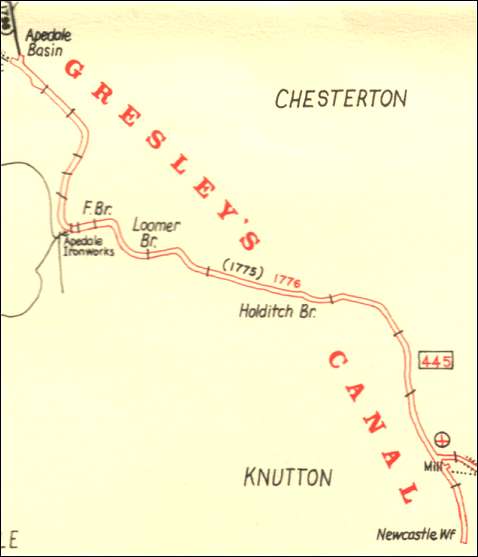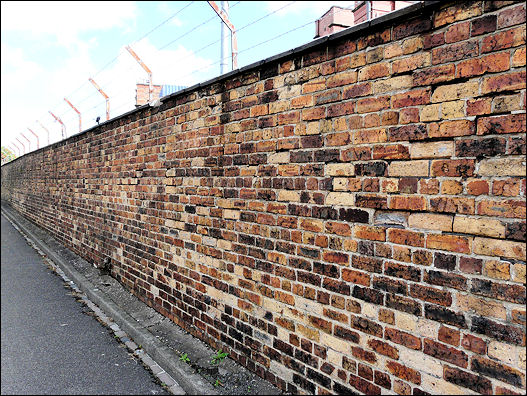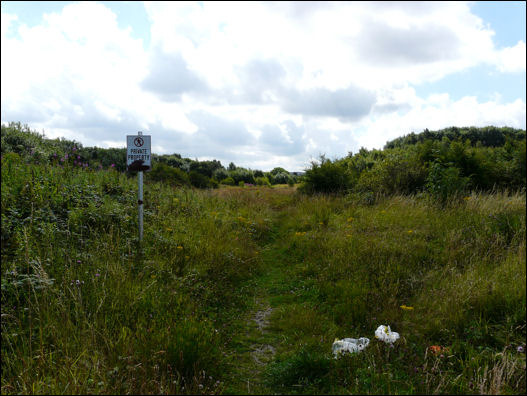|
Sir Nigel Gresley's Canal
(Newcastle-under-Lyme Upper Canal)
"Tracing
a canal via blackberries"
  
click the
"contents" button to get back to the main index & map
Next: Dalehall, Burslem
previous:
Newcastle-under-Lyme
Junction canal
|
Historian Fred Hughes
writes....
The big clue is blackberries; yes, plump juice-filled berries hanging
heavily in English hedgerows. You’d think they’d be lining some country
lane. But no, here they are, forests of them clustered yards deep along
the unseen byways of urban Newcastle.
“And that’s the giveaway,” historian Jim Worgan told me last week.
“Blackberry bushes were a feature of railway embankments and canal
towpaths. They were easily propagated and bees love them. You see,
blackberry flowers are good nectar producers and once they take hold they
remain there forever.”
For the final leg of my journey along the Newcastle Canals I’m accompanied
by Potteries’ historian Paul Nibblet and his wife Kathy, author and expert
in 20th century ceramics. We’re searching for the route of the
Apedale Canal and have been joined by canal enthusiast and Newcastle
resident Colin Ramsell.

the route of Gresley's
Canal
map from: Canals of North Staffordshire
It was a 3
mile level private canal from Sir Nigel Gresley's collieries at Aperdale
to Newcastle-under-Lyme.
Authorised by an Act of
Parliament in 1775, closed in c.1857
|
“I’ve been searching for the bed of the canal for quite some time,”
explains Colin. “I worked for Newcastle council for many years and know
this part of the town well. It really is impossible to trace the end of
the Gresley Canal to the coal wharf that was in the region of Newcastle
College. But we can pick up tell-tale signs when we walk along Wilton Way.
This is where Gresley’s Canal met the Junction Canal. You can still see a
wall running to the rear of Swift House occupied by a motorcycle retail
store. Before it was modernised it was a huge mill which you can still see
behind the modern façade at the rear.”
Sure enough here is Colin’s Victorian brick wall; long, high and straight.

Canal wall separating old mill from canal
behind Swift House, Cross Heath - this is the spot where Newcastle
Junction canal meets Gresley's canal
“It is typical for its times and you can imagine the canal running
alongside it as it made its way north to Milehouse, to Chesterton and the
Apedale mines,” says Paul.
“It’s something you don’t notice and don’t necessarily look for,” adds
Kathy. “It’s hard to conceive how long it has stood here undisturbed.”
The wall stretches for 50 yards until it is halted by an enclosed field at
the rear of Charter Road. In order to circumnavigate the obstruction we
have to walk to King Street where the picture becomes clearer. And it gets
better.
“Here we are,” says Paul. “Now we can see straight along the line at the
rear of Charter Road. And, hello, what do we have here!”
Paul has discovered a procession of blackberry bushes bending under the
weight of shimmering ebony fruit. Give it a week and it will be too late
for blackberry pies for this overripe store is about to burst un-plucked.
Here, in this district of Cross Heath amidst advanced Renew redevelopment,
Paul has found an unvisited and unexplored orchard of industrial
Newcastle. And naturally we lunch on the sticky sweetness of ancestral
berries.
“It’s impossible to guess how long these bushes have been here but I can
imagine them alongside the canal can’t you,” says Paul
|
Now Colin comes up with another surprise.
“I have discovered a house in King Street that stands in a different
direction to the others,” he claims. “I’m sure this was once the vicarage
to St Michael’s Church. If so it must have stood right next to our canal.”
We’re in luck encountering Sandra Cook a resident of King Street for 33
years.
“Yes you’re absolutely right about the old vicarage. In fact our house was
once part of the vicarage grounds. It was actually built on the tennis
courts,” says Sandra pointing out the location on Paul’s map. “The canal
ran along the bottom of the vicarage gardens and passed through my
neighbour’s plot emerging in Milehouse Lane, through the Meadows road and
across some land which was called the Cut where it connected with Holditch
Colliery. Before the estate was built the vicar would have uninterrupted
views across Knutton and Keele.”
The eponymous, the Cut, makes sense. Here you can visualise the canal line
along Meadows road. But that is it. Only satellite observation from this
point gives any clue to Gresley’s canal long buried with the ubiquitous
coalmines by new industrial estates. At some point it passed Loomer Road
stadium pushing its trail through moonscape terrain ravaged by pits and
tips. My enduring fellow-traveller Steve Birks catches up.

the bed of Gresley's anal coming into Apedale
-
this area is still industrial - the only part not changed by land
reclamation of country park.
“I don’t know how long you want to spend searching,” he says, “But
there’s not much evidence left. I can tell you the valley was carved by
ice-age movement some 20,000 years ago. Its mineral deposits ensured it
was at the forefront of the Industrial Revolution and intense coal and
iron mining at Apedale spanned at least 200 years. Gresley had it all
for some thirty years transporting coal along his canal which was first
dug at his colliery called Burley after a nearby farming location. The
forgotten Burley Colliery closed in 1926.”
Following a decade of opencast mining in the 1980’s Apedale has been
transformed into an inspiring country park. And it really is impossible to
see how it looked 200 years ago during the brief period of the canal age
before the railways arrived to make Britain the most powerful nation on
earth.
 more on the
Gresley's canal
more on the
Gresley's canal
|
![]()
![]()
![]()